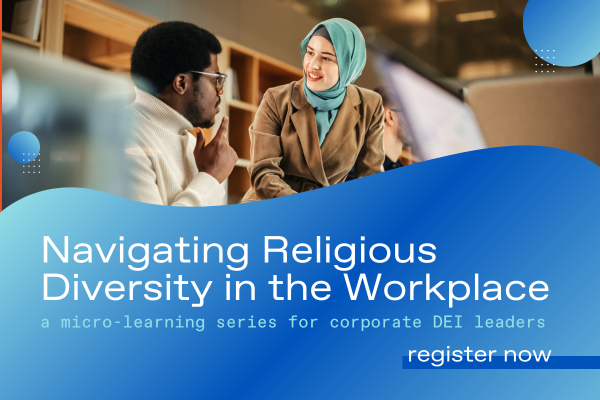(Harvard Business Review) — It is time for companies to get religion. Even as diversity work has become pervasive in corporate cultures, religious identity is too often left out. A review of the Fortune 100 companies demonstrates that a very small percentage include religion or interfaith engagement in their approach to diversity.
Many corporations shy away from such engagement out of a fear of legal entanglement, or a worry that it might open the floodgates to proselytization and disagreement. But including religion in your DEI efforts can create belonging among employees and help them better serve a wider range of customers. And recent research and practice show that honoring religious identity not only leads to greater employee engagement, but also has benefits beyond employee morale.
Here are seven best practices companies should adopt to positively engage with and benefit from religious diversity in the workplace.
Change your mindset from “religion is a risk” to “religion is an asset.”
Sixty-two percent of people in the world define themselves as religious, and even more say they believe in God. Seventy-seven percent of Americans say religion is very or somewhat important in their lives. Roughly 30% of social sector organizations in the United States have a faith affiliation and are providing critical services for people of all religious or nonreligious backgrounds. At the same time, as hate crimes related to religion are on the rise nationally, many Americans view religion as a topic not fit for the workplace, citing interpersonal conflicts, tensions among peers, safety concerns, and legal conflicts as possible outcomes.
Companies that openly acknowledge and engage religious diversity as an asset, however, can strengthen team cohesion and improve performance. Accenture, for example, is designated as the number one Global 500 “faith and belief friendly company,” according to the 2023 Religious Equity Diversity and Inclusion (REDI) Index. Accenture offers inclusive holiday policies and religious literacy training, among other hallmarks. At the first annual Faith & Belief @ Work case competition, held at Brigham Young University in February, Sumreen Ahmed, a global change management lead at Accenture, spoke to the power of engaging religious diversity: “If leaders want to create an environment where people are not only incentivized to come to work but also where they can thrive for the greater good, they need to start by understanding what matters most.”
Treating religion as an asset and giving employees permission to talk about religion at work is the first step to harnessing the power of religious diversity.
Articulate clear guidelines for engaging religious diversity inside your company.
Americans say they encounter religious diversity at work more than in any other sphere of their lives. As we argue here, diverse identities and perspectives in the workplace can lead to stronger teams and greater outcomes, but if not engaged properly, they can also lead to misunderstanding and conflict.
Religious inclusion at work must respect the dignity of all employees: those who choose to express their religious identities, those who claim no religious identity, and those who choose not to disclose their religious identity. Establishing a set of principles that detail how a company will engage religion can mitigate anti-religious or interreligious bias, prevent potential interpersonal tensions from escalating, and encourage innovative ways to activate religious diversity for the benefit of all. Tips for creating a framework include:
- Link the framework to existing company values
- Underscore the positive contributions of religious identity and diversity
- Acknowledge support for expressing religious identities in the workplace
- Establish guardrails to ensure equal treatment across diverse groups
- Encourage opportunities for collaboration across religious, spiritual, and secular identities
- Lift up professional development resources available to employees to deepen knowledge of diverse religious traditions
Cecilia Persson-Ramos, DEI ERG leader at Intuit, proactively adopted a set of principles last summer to guide the company’s faith-based ERGs. Included in the principles is support for each ERG as it observes its particular religious practices, while also encouraging ERGs to work with one another on collaborative events. “We’ve already started to see the impact,” she told us. “Members feel seen and heard and there’s increased cooperation for the good of the whole community.”
Develop religious literacy to recognize religious diversity.
Companies can grow their businesses by cultivating an eye for issues related to religious expression. Just ask Martha Moore, who developed Nike’s Victory Swim Collection after noticing Muslim women sitting on the shore instead of going in the water while on a beach vacation. She recognized a market for modest swimwear for hundreds of millions of Muslim women around the world by paying attention — and generated millions in revenue for Nike as a result.
Meeting the needs of a particular religious community can also serve to elevate a brand and build loyalty among a subset of customers. For example, Google offers a qibla finder to help Muslims anywhere in the world orient toward the Kaaba in Saudi Arabia for their five daily prayers.
At the same time, neglecting to recognize religious expression at work can lead to legal consequences. In EEOC v. Abercrombie, the Supreme Court ruled 8–1 in favor of Samantha Elauf, the young Muslim woman who wasn’t offered a job at an Abercrombie store in Tulsa, OK because her hijab didn’t comply with Abercrombie’s “look policy.” In the majority opinion, Justice Scalia held that it is incumbent upon the employer to know when an article of clothing is related to religious expression.
Companies are responsible, under the law, for equipping team members with the skills to effectively recognize and accommodate religious identity in the workplace. More than that, having an eye for religious diversity can lead to new product development.
Know the law — but not for the reasons you think.
Risk is frequently cited as one of the biggest barriers to religious engagement for C-suite leaders. However, not engaging religious identity as part of corporate culture is the riskier choice. Provided that is pursued in a respectful and equitable manner, the benefits for a company in openly engaging religious identity at work outweigh the risks of breaking what some see as a “church-state” firewall, or the secular tone of the corporate setting.
Andrea Lucas, a commissioner at the Equal Employment Opportunity Commission, is an outspoken advocate for engaging religious identity in the workplace as the best way to avoid a lawsuit. The EEOC’s Compliance Manual on Religious Discrimination offers up-to-date guidelines and practical case studies to support business leaders as they navigate tricky issues related to religion at work. According to Lucas, it’s companies that avoid religious identity that end up in challenging positions.
Companies should advocate for education around legal risks and remedies and seek ways that religious inclusion can be a brand builder, not a risk minefield.
Provide meaningful and flexible accommodations for employees’ diverse religious practices.
Many aspects of religious expression intersect with company policies, like time off and scheduling. Here’s how some companies have provided accommodations:
- Holidays: When creating time off policies, companies can offer floating holidays, giving employees the flexibility to choose which holidays are meaningful to them, whether religious or secular. Google took it one step further and made an inclusive scheduling guide for employees on accommodating diverse religious practices.
- Dietary restrictions: Adherence to different religious traditions often includes dietary restrictions: Some Hindus do not eat beef, some Muslims and Jews do not eat pork, some Mormons do not drink caffeine or alcohol, and some Buddhists are vegetarian. At Interfaith America, we gather dietary restrictions during the onboarding process, which are then populated into a shared document available to all managers who order food for work events.
- Spaces for observance: Companies can provide a designated prayer or meditation space in the office for employees of any faith or tradition to pray or reflect. For example, Texas Instruments provides 24/7 access to serenity rooms at several of their campuses.
Offer ongoing religious diversity skill-building opportunities for all employees.
Rev. David Keck, chaplain at Embry-Riddle Aeronautical University in Daytona Beach, Florida, tells the story of a fellow faculty member who, when he was a commercial pilot, was alerted by his crew before takeoff to a man who was moving his body rhythmically and speaking a foreign language. Rather than succumb to knee-jerk racial profiling and/or anti-religious bias, the pilot drew on his religious literacy to ascertain that the man was simply praying with his whole body, as Orthodox Jews (and many others!) do daily. The pilot reassured his crew and the flight took off as scheduled. Keck prompts the students in his Religion, Conflict, and Peace class to imagine how the story would have turned out differently — and likely led to unfavorable news headlines — had the pilot not been familiar with Jewish prayer practices.
From interns to senior executives, employees across every sector need skills and knowledge to engage religious diversity to be successful in their roles. Sixty percent of companies in North America offer regular diversity trainings for their employees, but few include a robust focus on religion. Best practice pedagogy from Interfaith America’s 20-year history of training and equipping leaders to engage religious diversity includes case studies, storytelling, and practical application to inspire and equip team members for success.
Upskilling a company’s workforce to meaningfully engage religious diversity in a nuanced and constructive way will pay dividends across the organization.
Support interfaith ERGs and other employee-led efforts to engage religious diversity.
Interfaith Employee Resource Groups (ERGs) are one important tool for creating an inclusive workplace culture. According to the 2023 REDI Index, only 8.6% of Fortune 500 companies publicly report having faith-oriented ERGs.
Salesforce’s Faithforce is one example of a best-in-class employee-led interfaith effort to build belonging across diverse identities. From the beginning, Faithforce leadership made it clear that their goal was not proselytizing or politics, but focused instead on engaging religion as part of the company’s diversity efforts. Farah Siddiqui, cofounder and global president of Faithforce from 2017 to 2021 (and now supporting faith inclusion at Google) shares lessons learned with leaders looking to jumpstart interfaith engagement in their workplaces.
Hallmarks of high-impact interfaith ERGs include:
- A clear charter naming what it is and is not appropriate behavior
- Celebrations of religious holidays to support team members and educate others
- Events focused on exploring shared values
- Resources explaining diverse religious traditions
- Community collaborations in response to a humanitarian crisis
American corporations have long sought to avoid religious engagement in the workplace, fearing legal risks and the unfamiliar terrain of engaging the multiplicity of religious traditions in an ever-increasingly diverse workforce. By proactively engaging religious diversity at work, companies prevent crises, broaden brand loyalty, strengthen company culture, and increase team cohesion and effectiveness.
This article was originally published in the Harvard Business Review. Read the original article.





